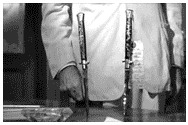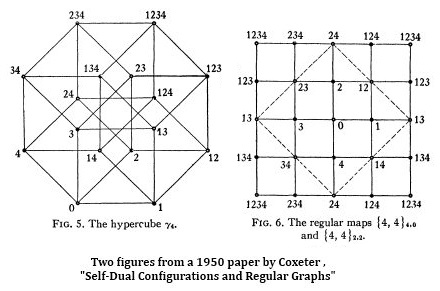|
Related material: Exhibit B Julie Taymor |
Saturday, April 30, 2011
Sabato Tombstone
Monday, May 13, 2019
“The Eyes of Orson Welles”…
is a TCM special at 8 PM ET this evening.
A snow-globe phrase from April 28 —
Bauble, Babel . . . Bubble —
The "bubble" cited above —
For more metaphysical accounting, see
The Church of Synchronology.
Wednesday, June 14, 2017
Graphical Interfaces
Thacker reportedly died on Monday, June 12, 2017.
This journal on that date —
Thacker retired from Microsoft in February.
Saturday, March 18, 2017
Gamers
A search for Gamers in this journal yields …

This is not unrelated to the title of a 2008
book by Jeremy Gray:
Plato's Ghost:
The Modernist Transformation
of Mathematics .
Wednesday, July 16, 2014
Thursday, August 16, 2012
Raiders of the Lost Tesseract
(Continued from August 13. See also Coxeter Graveyard.)
Here the tombstone says
"GEOMETRY… 600 BC — 1900 AD… R.I.P."
In the geometry of Plato illustrated below,
"the figure of eight [square] feet" is not , at this point
in the dialogue, the diamond in Jowett's picture.
An 1892 figure by Jowett illustrating Plato's Meno—
Jowett's picture is nonetheless of interest for
its resemblance to a figure drawn some decades later
by the Toronto geometer H. S. M. Coxeter.
A similar 1950 figure by Coxeter illustrating a tesseract—
For a less scholarly, but equally confusing, view of the number 8,
see The Eight , a novel by Katherine Neville.
Thursday, October 20, 2011
The Thing Itself
Suggested by an Oct. 18 piece in the Book Bench section
of the online New Yorker magazine—
Related material suggested by the "Shouts and Murmurs" piece
in The New Yorker , issue dated Oct. 24, 2011—
"a series of e-mails from a preschool teacher planning to celebrate
the Day of the Dead instead of Halloween…"
A search for Coxeter + Graveyard in this journal yields…
Here the tombstone says "GEOMETRY… 600 BC — 1900 AD… R.I.P."
A related search for Plato + Tombstone yields an image from July 6, 2007…

Here Plato's poems to Aster suggested
the "Star and Diamond" tombstone.
The eight-rayed star is an ancient symbol of Venus
and the diamond is from Plato's Meno .
The star and diamond are combined in a figure from
12 AM on September 6th, 2011—
The Diamond Star

See Configurations and Squares.
That webpage explains how Coxeter
united the diamond and the star.
Those who prefer narrative to mathematics may consult
a definition of the Spanish word lucero from March 28, 2003.
Monday, November 29, 2010
Philosopher’s Stone
Happy Ending
Part I —
Plato's
Tombstone
Part II —
Star and Diamond
United

(See previous post and
a note on design.)
Sunday, June 27, 2010
Bright Star (continued)
From Epiphany 2010—
The more industrious scholars will derive considerable pleasure from describing how the art-history professors and journalists of the period 1945-75, along with so many students, intellectuals, and art tourists of every sort, actually struggled to see the paintings directly, in the old pre-World War II way, like Plato's cave dwellers watching the shadows, without knowing what had projected them, which was the Word."
– Tom Wolfe, The Painted Word
Pennsylvania Lottery yesterday—
Saturday, June 26, 2010: Midday 846, Evening 106
Interpretation—
Context:
Yesterday's morning post, Plato's Logos
Yesterday's evening post, Bold and Brilliant Emergence
Poem 846, Oxford Book of English Verse, 1919:
"bird-song at morning and star-shine at night"
Poem 106, Oxford Book of English Verse, 1919:
" All labourers draw home at even"
The number 106 may also be read as 1/06, the date of Epiphany.
Posts on Epiphany 2010—
9:00 AM Epiphany Revisited
12:00 PM Brightness at Noon
9:00 PM The Difference
Related material—
Plato's
Tombstone
Wednesday, April 30, 2008
Wednesday April 30, 2008
Lucy in the Sky
with Diamonds
and Sacred Heart
PARIS — Albert Hofmann, the mystical Swiss chemist who gave the world LSD, the most powerful psychotropic substance known, died Tuesday at his hilltop home near Basel, Switzerland. He was 102.
Related material:
and
a film by Julie Taymor,
Across the Universe:
Detail of the
Strawberry Fields Forever
Sacred Heart:
A song:Julie Taymor
“Shinin’ like a diamond,
she had tombstones
in her eyes.”— Album “The Dark,”
by Guy ClarkFor related tombstones,
see May 16-19, 2006,
and April 19, 2008.Further background:
Art Wars for
Red October.
Thursday, November 29, 2007
Thursday November 29, 2007
|
From today's online NY Times:
Obituaries in the News
By THE ASSOCIATED PRESS
Published: [Wednesday] Gennie DeWeese BOZEMAN, Mont. (AP) — Gennie DeWeese, an artist known for her landscape paintings and woodblock prints whose works are displayed at museums across the Northwest, died Monday [November 26, 2007]. She was 86. DeWeese died at her studio south of Bozeman. Dahl Funeral Chapel confirmed her death. Her first oil painting was of her dog, done when she was 12 years old. In 1995, DeWeese received an honorary doctorate of fine arts from Montana State University, and she received the Montana Governor's Award for the Arts. |
Robert M. Pirsig in
Zen and the Art of Motorcycle Maintenance
(April 1974) —
|
"The rhetoricians of ancient Greece were the first teachers in the history of the Western world. Plato vilified them in all his works to grind an axe of his own and since what we know about them is almost entirely from Plato they’re unique in that they’ve stood condemned throughout history without ever having their side of the story told. The Church of Reason that I talked about was founded on their graves. It’s supported today by their graves. And when you dig deep into its foundations you come across ghosts." I look at my watch. It’s after two. "It’s a long story," I say. "You should write all this down," Gennie says. |
Quod erat
demonstrandum.
For more information,
click on the black monolith.
Related material:
Friday, July 6, 2007
Friday July 6, 2007
of Good and Evil
continued from
Midsummer Night…
— Glenna Whitley, “Voodoo Justice,”
The New York Times, March 20, 1994

In Other Game News:
“Coxeter Exhuming Geometry”
suggests the following
illustration, based
in part on
Plato’s poem to Aster:

Related material:
and
The proportions of
the above rectangle
may suggest to some
a coffin; they are
meant to suggest
a monolith.
Wednesday, May 17, 2006
Wednesday May 17, 2006
Tombstone
From today's New York Times:
"Jiri Frel, a mercurial and eccentric curator who helped build the J. Paul Getty Museum into a major center for Greek and Roman art but resigned after revelations about unscrupulous acquisition practices, died on April 29. He was 82…. a well-regarded expert in Greek tombstones…."
"ATHENS, May 16 — After four hours of talks here with the Greek culture minister, the director of the J. Paul Getty Museum in Los Angeles said Tuesday that he would press for the return of some of the Getty's most prized ancient artifacts to Greece…. Greece is seeking the repatriation of a… tombstone…."
From a photo accompanying the obituary:

Museum
window

To Aster, from Plato
Asteras eisathreis, Aster emos.
Eithe genoimen ouranos,
'os pollois ommasin eis se blepo.
You gaze at stars, my Star.
Would that I were born the starry sky,
that I with many eyes might gaze at you.
Related material:
Friday, September 17, 2004
Friday September 17, 2004
God is in…
The Details
From an entry for Aug. 19, 2003 on
conciseness, simplicity, and objectivity:
Above: Dr. Harrison Pope, Harvard professor of psychiatry, demonstrates the use of the Wechsler Adult Intelligence Scale "block design" subtest. Another Harvard psychiatrist, Armand Nicholi, is in the news lately with his book The Question of God: C.S. Lewis and Sigmund Freud Debate God, Love, Sex, and the Meaning of Life.
For the meaning of the Old-Testament logos above, see the remarks of Plato on the immortality of the soul at For the meaning of the New-Testament logos above, see the remarks of R. P. Langlands at |
On Harvard and psychiatry: see
The Crimson Passion:
A Drama at Mardi Gras
(February 24, 2004)
This is a reductio ad absurdum of the Harvard philosophy so eloquently described by Alston Chase in his study of Harvard and the making of the Unabomber, Ted Kaczynski. Kaczynski's time at Harvard overlapped slightly with mine, so I may have seen him in Cambridge at some point. Chase writes that at Harvard, the Unabomber "absorbed the message of positivism, which demanded value-neutral reasoning and preached that (as Kaczynski would later express it in his journal) 'there is no logical justification for morality.'" I was less impressed by Harvard positivism, although I did benefit from a course in symbolic logic from Quine. At that time– the early 60's– little remained at Harvard of what Robert Stone has called "our secret culture," that of the founding Puritans– exemplified by Cotton and Increase Mather.
From Robert Stone, A Flag for Sunrise:
"Our secret culture is as frivolous as a willow on a tombstone. It's a wonderful thing– or it was. It was strong and dreadful, it was majestic and ruthless. It was a stranger to pity. And it's not for sale, ladies and gentlemen."
Some traces of that culture:
|
A web page |
A contemporary Click on pictures for details. |
A more appealing view of faith was offered by PBS on Wednesday night, the beginning of this year's High Holy Days:
|
Armand Nicholi: But how can you believe something that you don't think is true, I mean, certainly, an intelligent person can't embrace something that they don't think is true — that there's something about us that would object to that.
Jeremy Fraiberg: Well, the answer is, they probably do believe it's true. Armand Nicholi: But how do they get there? See, that's why both Freud and Lewis was very interested in that one basic question. Is there an intelligence beyond the universe? And how do we answer that question? And how do we arrive at the answer of that question? Michael Shermer: Well, in a way this is an empirical question, right? Either there is or there isn't. Armand Nicholi: Exactly. Michael Shermer: And either we can figure it out or we can't, and therefore, you just take the leap of faith or you don't. Armand Nicholi: Yeah, now how can we figure it out? Winifred Gallagher: I think something that was perhaps not as common in their day as is common now — this idea that we're acting as if belief and unbelief were two really radically black and white different things, and I think for most people, there's a very — it's a very fuzzy line, so that — Margaret Klenck: It's always a struggle. Winifred Gallagher: Rather than — I think there's some days I believe, and some days I don't believe so much, or maybe some days I don't believe at all. Doug Holladay: Some hours. Winifred Gallagher: It's a, it's a process. And I think for me the big developmental step in my spiritual life was that — in some way that I can't understand or explain that God is right here right now all the time, everywhere. Armand Nicholi: How do you experience that? Winifred Gallagher: I experience it through a glass darkly, I experience it in little bursts. I think my understanding of it is that it's, it's always true, and sometimes I can see it and sometimes I can't. Or sometimes I remember that it's true, and then everything is in Technicolor. And then most of the time it's not, and I have to go on faith until the next time I can perhaps see it again. I think of a divine reality, an ultimate reality, uh, would be my definition of God. |
|
|
|
Gallagher seemed to be the only participant in the PBS discussion that came close to the Montessori ideals of conciseness, simplicity, and objectivity. Dr. Montessori intended these as ideals for teachers, but they seem also to be excellent religious values. Just as the willow-tombstone seems suited to Geoffrey Hill's style, the Pythagorean sangaku pictured above seems appropriate to the admirable Gallagher.

























